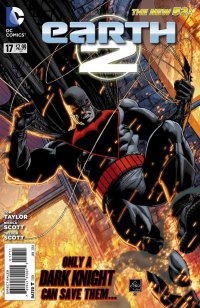 Earth 2 #17 (DC Comics, $2.99)
Earth 2 #17 (DC Comics, $2.99)
By Graig Kent
It’s interesting that at the same time as DC is fueling its Earth 2 lineup, Marvel seems to be collapsing its secondary universe (in Cataclysm). I read the first issue of Earth 2 when it debuted but my issues with James Robinson’s scripting kept me from continuing with it further. Delving into it a second time, Earth 2 seems to serve the same purpose as Marvel’s Ultimate line: it gives DC the opportunity to do anything they want with their characters in a serialized context without it really being meaningful.
Entering this second phase of Earth 2 with Tom Taylor (the writer of Injustice: Gods Among Us, not the protagonist of The Unwritten), Superman has returned from the dead, only to be under Darkseid’s control. Having badly beaten most of the heroes of Earth 2 with ease, things are looking pretty dire, but the new Batman has a plan and it may or may not involve Lois Lane, who now inhabits Red Tornado’s body. As I said, this is an Earth where anything can happen, and it does. Whether it should, I dunno.
It’s a curious book, one that has few ties to anything DC has done before, but at the same time treads heavily on character recognition. It’s at once kind of ultra-accessible and yet utterly impenetrable to all but the die hardest DC fans. I think an average reader would really be questioning a murderous Superman (oh wait…maybe not *cough*ManofSteel*cough*) or a super-robot Lois Lane, but the DC devotee would probably be quite welcoming of the change. Some of the events of the book seem well over the top in Mark Millar-esque fashion, but at the same time there’s a refreshing sense of freedom that most of the New 52 elsewhere doesn’t have. I mean three pages of Superman stomping on Dr. Fate’s head…? I don’t know whether to be put off or impressed.
Nicola Scott was a favourite of mine on Secret Six and Teen Titans prior to the New 52 reboot and it was with more than a bit of regret that my distaste for Robinson’s writing kept me from reading this title, but I have to say, as much as I like her character work and her storytelling, if she’s responsible for the costume design, it’s some of the worst since George Perez’s mid-80’s Teen Titans creations.
I can’t recommend it, and I’m undecided as to whether I will continue reading it or not myself (though Taylor nicely hints at what’s to come after Dr. Fate comes out of his tussle with DarkSeups, and I am intrigued), but I wouldn’t dissuade anyone from reading it either or mock them for finding this terribly entertaining.
Rating: 




Out of a Possible 5 Stars
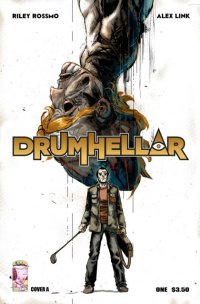 Drumhellar #1 ($3.50, Image)
Drumhellar #1 ($3.50, Image)
by D.S. Randlett (@dsrandlett)
Here’s a dirty, dirty confession from a very small time comic book critic: I tend to follow writers, and evaluate comic books on how well written they are, or at least how well written I perceive them to be. Very many of comics’ greatest luminaries, Jim Steranko, for one, insist that the medium is chiefly the province of, if not artists, then of art. Under this view, art and its role in the narrative is the primary standard of evaluation in terms of comics, and quality of writing takes second seat. This is something that I have trouble coming to terms with, as I think of myself primarily as a writer and a reader in general, but sometimes I think that it might be the right view. And if it is, then I have never truly read a comic book, and likely never will. When I think of a medium that has given me so much, and the possibility that the fact is that I will always be at a remove in terms of my appreciation and adoration of it, I can’t help but feel the screws turn a bit.
But then I remember that, in some rare occasions, an artist will catch my eye, and that I do in fact follow artists. Brandon Graham is one such artist. Another is Riley Rossmo. Rossmo first caught my eye with Debris, an alright series elevated by his art. He tends to get hired for stuff in that vein, all ages sci-fi stories that benefit from his Tezuka influence, such as a recent story he did for DC’s superlative digital Adventures of Superman series. But a look at his work beyond those types of comics reveals an artist with a startling sense of range. Judging from the debut of his Image series Drumhellar, which has writes with Alex Link, he intends to display that range.
As a story, Drumhellar feels a lot like a lot of other artist-driven books in that it has certain fever dream qualities that allow the images to become less rigid than if they were confined by a more typical script. Writers tend to pace things in terms of speech and events, which is exemplified by Alan Moore’s work on Watchmen, where he uses a pretty strict panel structure to establish certain rhythms in narrative and speech. Rossmo opts instead for establishing an aesthetic, and he creates a fitting world to do so in.
Drum Hellar is a sort of paranormal detective. Comics have plenty of those in the wake of Hellboy and Hellblazer, but Rossmo and Link find ways to put their own stamp on the trope. I suppose that there is some John Constantine in Drum Hellar, but where Constantine is the clever and aggressive former punk who’s too cool for most rooms, Drum is more of a good natured hippie type, using hallucinations to get to the bottom of the mysteries that he’s drawn to. Instead of a smart snappiness, Drum’s voice comes off the page as something more in the vein of a kinder Steven Wright. Not a punk, but rather a hippy. Narratively, the hook doesn’t come until the rather awkward final page, but Rossmo takes the reader on an effective tour of the strange worlds that Drum inhabits.
Even if you mainly follow writers, Rossmo proves once again that he’s an artist that anyone can connect with. If you’re not on his bandwagon yet, now’s a good time to start.
Rating: 




Out of a Possible 5 Stars
A Digital Deluge from Graig Kent:
The sheer volume of comic books available is staggering. Much like television, film and music, the digital age of media has made not only accessing comics a lot easier but making and distributing them too. The market is loaded with material, with hundreds of new issues appearing every month and millions of past issues available with but a few clicks. Keeping up with what’s new in the physical, brick-and-mortar realm is challenging enough, but with so many digital-only or digital-first titles scantily promoted it’s very, very difficult keeping up with fresh digital material, or even knowing what’s new amidst all the republished or collected material online.
Still uncomfortable with this bold new world of sequential art (bold and new only in acceptance, when Scott McCloud wrote of the digital platform in Reinventing Comics back in 2000, his thoughts were already being applied in practice), I tend to check in on the digital offerings only a few times a year. Plus, I already spend enough on traditional offerings, need I spend more? Well, when you find stuff as good as these, it’s worth shedding a few extra bills from time to time.
—
The Double Life of Miranda Turner #1 (Monkeybrain, $0.99) is a charming all-ages comic that finds its young 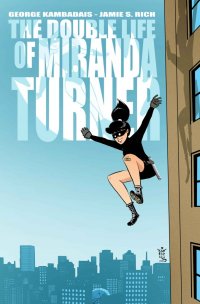 heroine, Miranda Turner, aka “The Cat” in over her head against two rather innocuous villains, a pair of Lego-esque block-gushing punks in Devo-like jumpsuits and cone hats called the Blockheads flooding the city with their bricks. The Cat is an established hero, but the reality is that Miranda is new to the guise, taking over from her sister, Lindy, who originated the role and whose ghost now haunts/guides her.
heroine, Miranda Turner, aka “The Cat” in over her head against two rather innocuous villains, a pair of Lego-esque block-gushing punks in Devo-like jumpsuits and cone hats called the Blockheads flooding the city with their bricks. The Cat is an established hero, but the reality is that Miranda is new to the guise, taking over from her sister, Lindy, who originated the role and whose ghost now haunts/guides her.
The first issue plays out more like a conventional pilot issue, establishing the central character and the series tone — which leans towards lightheartedness with a tinge of darkness overhead — but setting up no larger story points. Writer Jamie S. Rich promises that there will be a bigger story at play but even if it was a series of similarly styled done-in-ones like this it would be thoroughly enjoyable. I genuinely enjoy the conceit of a dead sibling acting as mentor to her costumed successor, but the Blockheads are perhaps my favourite villain conceit in a long time. It’s all illustrated in a pseudo-Bruce Timm or Darwyn Cooke-like style by George Kambadais that is perfect for the tone of the series, and accentuated by the vibrant colors of Christopher Crank.
Rating: 




Out of a Possible 5 Stars
—
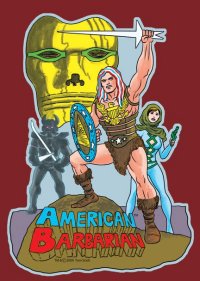 A lot of digital comics start life as serialized daily or weekly strips and then get collected together as a packaged digital (or often physical) release. Warren Ellis’ Freakangels was one of the biggest successes of this a few years back, but it’s a model that has been repeated countless times since, up to and including Mark Waid and John Rogers’ model for their Thrillbent comics line. Tom Scioli’s American Barbarian #1 (Self-Published, $0.99 from Comixology) started life as a relatively daily serialized story, but was drafted as a traditional comic, so the serialization often found a single page broken out across multiple days. Presented on a page-by-page basis, it comes together as a more cohesive narrative and it’s a lot easier to read through Comixology’s digital interface, rather than having to click through and reload page after page.
A lot of digital comics start life as serialized daily or weekly strips and then get collected together as a packaged digital (or often physical) release. Warren Ellis’ Freakangels was one of the biggest successes of this a few years back, but it’s a model that has been repeated countless times since, up to and including Mark Waid and John Rogers’ model for their Thrillbent comics line. Tom Scioli’s American Barbarian #1 (Self-Published, $0.99 from Comixology) started life as a relatively daily serialized story, but was drafted as a traditional comic, so the serialization often found a single page broken out across multiple days. Presented on a page-by-page basis, it comes together as a more cohesive narrative and it’s a lot easier to read through Comixology’s digital interface, rather than having to click through and reload page after page.
I’ve yet to get around to reading G0dland, Sciolis’ long-term Cosmic-Kirby homage with Joe Casey, but American Barbarian certainly is providing the inspiration to do so. The first of six issues, Scioli looks more at OMAC and Kamandi for influence, in an excessively Kirby-esque dystopian future where lands have returned to segregated fiefdoms with tenuous treaties between them. The great warrior and guardian Yoosamin has yielded seven sons, now mostly grown men and warriors themselves. They compete in an ancient ritual to determine their fates, but the youngest son changes all their destinies and in return becomes the American Barbarian. Years later the warrior sons serve at the fore of King Lionhorn’s defence, and are needed as the Two-Tank Omen, a giant Egyptian-esque god-like figure with tanks for feet is on the march with his terrible army. Will even these noble servants be able to stop him?
It’s joyfully ridiculous and direly earnest in all the best ways that eccentric ‘70’s Kirby materials were. Scioli is obviously a Kirby devotee, and models this entire project in his image. Scioli’s art is a bit clunkier than the King’s, his figure work more primitive and stiff, and character consistency an issue from panel to panel, but the sheer wide-eyed science fantasy of it more than makes up for any artistic failing.
Rating: 




Out of a Possible 5 Stars
—
The solicitation for The Rockthrower #1 [New Paradigm Studios, $1.99] involved such an unusual conceit for a comic 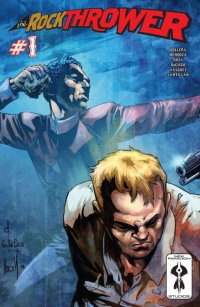 book that I just had to read it, if only to see how such a story could be executed in the medium. The premise is actually quite intriguing: a down-on-his-luck ex-pro pitcher turned baseball recruiter sees a news report on Israeli/Palestinian conflicts and keys in on a teenager hurtling rocks at soldiers with precision aim and speed. Naturally he wants to find the boy, and just as naturally there’s a lot of unfamiliar, potentially hostile environments to traverse in doing so.
book that I just had to read it, if only to see how such a story could be executed in the medium. The premise is actually quite intriguing: a down-on-his-luck ex-pro pitcher turned baseball recruiter sees a news report on Israeli/Palestinian conflicts and keys in on a teenager hurtling rocks at soldiers with precision aim and speed. Naturally he wants to find the boy, and just as naturally there’s a lot of unfamiliar, potentially hostile environments to traverse in doing so.
The story from Brandon Parlow and scripter Karl Bollers (with a trio additional developers credited on top of them) is quite well done, starting with an opening feint in which David Willis, the recruiter, is seemingly being held for ransom by turbaned Middle-Eastern types, and a peculiar ransom at that, involving interrupting a championship baseball game with a phonecall. From there it plays out far more lightheartedly than expected. Bollers’ script is sharp and punchy, with quite a few genuinely funny moments. Artist Dave Ross, a veteran of the industry for 30 years now, is prominently credited though he only provides the layouts, but hiring Ross for layouts pays incredible dividends in the storytelling department. Finisher Gene DiCicco is a good artist, particularly with faces and expressions, though a little weaker on full-body physicality, but over the layouts from Ross the story flows very smoothly and feels assured and professional. The colors from Ivan Santillan are surprisingly exceptional. Young comic companies generally suffer most in the coloring department, but Santillan uses a very robust and intriguing palette with a combination of watercolors and zipatone generating a truly distinct and appealing effect.
The combination of baseball and tense political themes did not seem to me to be a natural fit in the comics, domain, but I was more than proven wrong. Though it’s unconventional to be sure, the robust team of creators involved in this project have reminded me that comics done well can effectively utilize any genre and cover any topic. The typical comics audience might be wary of such a project, cynical even, as often high concepts like this seem like they’re just TV or movie pitches put to paper, but there’s a commitment to storytelling format here that cuts through that jaded view. The Rockthrower is a genuine surprise.
Rating: 




Out of a Possible 5 Stars
—
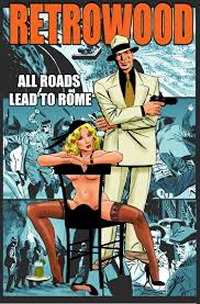 Mike Vosburg has done everything there is to do in comics over 40 years in the biz, but if there’s anything his artistic style and storytelling sensibility seem suited for it’s neo-Hollywood Noir. Though his latest mini-series, Retrowood: All Roads Lead To Rome #1 (of 3)(Asylum Press, Free on Comixology) just came out within the past few months, his “Retrowood” series has been running for a couple of years now, with a previous mini-series and a couple one-shots waiting in the wings.
Mike Vosburg has done everything there is to do in comics over 40 years in the biz, but if there’s anything his artistic style and storytelling sensibility seem suited for it’s neo-Hollywood Noir. Though his latest mini-series, Retrowood: All Roads Lead To Rome #1 (of 3)(Asylum Press, Free on Comixology) just came out within the past few months, his “Retrowood” series has been running for a couple of years now, with a previous mini-series and a couple one-shots waiting in the wings.
Retrowood is pulpy detective fiction set in a 1940’s Hollywood-style setting, but it’s not the quite real thing. This frees Vosburg to play with the conventions of the genre and setting without having to strictly adhere to the reality, thus no map consulting or wardrobe photo referencing required. Vosburg seems to work out his plot and then mull over the panel flow with freedom from being a stickler for details. Yet, he does so anyway, to an extent. He references what he needs and dispenses with what he doesn’t. Vosburg’s style has never been the most refined, but it’s so perfectly suited to this type of tabloid murder mystery tale, executed in black and white with such rigid panel structures as to suggest almost compiled from a serialized newspaper strip.
Vosburg wears his cinematic and prosaic influences proudly on his sleeve. He’s quite aware how derivative the genre and the stories within it can get but he doesn’t care. There’s a formula to this type of crime-and-glamour that belongs to that ‘40’s era and as Vosburg totally plays into it, stating “execution of the idea should trump originality anytime”. He clearly loves the genre, and fans of the it (and wayward fans of Vosburg) should most definitely be checking this out.
Rating: 




Out of a Possible 5 Stars
Painkiller Jane #1 of 4 (Icon, $3.99)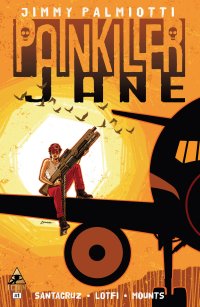
By Jeb D.
Jimmy Palmiotti has always struck me as your classic old-school Noo Yawk guy, and his best-known character creation reflects that: for all that Palmiotti has tried to find a take on Painkiller Jane that transcends the “badass girl with a gun” clichés (and certainly seems convinced that he has), the fact of the matter is that’s pretty much what she is, and all of Palmiotti’s good intentions tend be somewhat undercut by what feels like the worldview we’d expect from the Brooklyn street kid that he is (another cliché, for sure).
Painkiller Jane was the first real breakout for Palmiotti and Joe Quesada in the days when Marvel Knights was basically a franchise operation. She’s got backstory… boy, does she have backstory. Palmiotti takes no chances that new readers might need an introduction to the character, as this issue contains a potted origin-story recap, an extensive text piece devoted to every print and video iteration of the character, and introductory and concluding comments from Palmiotti, as well as a generous assortment of text boxes giving details of how Jane Vasko comes to be a loose cannon tough gal running roughshod through an airport and out into the streets of New York, in a fairly conventional action-movie storyline, with cascades of gunfire, car crashes, and explosions.
The problem with Painkiller Jane, and characters of her ilk, is that they’re built on inherently clichéd and limited male characters in the first place. While Palmiotti wants to stretch things a bit by making Jane bisexual, her romantic background isn’t any more or less interesting or relevant than are the domestic entanglements of John McClane or Harry Callahan. In the end, she’s mostly just the sum of her two-fisted template, and if you read none of the introductory material, the main story would make just as much sense. Oddly, in this comic, she also betrays a vaguely racist attitude, addressing a Hispanic man she’s just met as “Chico“, in a way that might have felt benignly wiseass from a Mike Hammer-era cop, but today suggests a writer straining to make an old-school worldview function in a modern framework.
If you’re new to Painkiller Jane, and you’re up for some action-hero comicbooking, this first issue offers two stories. The main feature is a fast-moving 20-page chapter, as Jane intervenes in a kidnapping, with art from Juan Santacruz: his work is lush and detailed, though sufficiently focused on splash scenes and butt shots to reinforce ones doubts about Palmiotti’s earnest protests of feminist subtext. Sam Lofti illustrates the 10-page backup piece recapping Jane’s origin, and his brisk, cartoony style would probably have been a better fit for the main story. Palmiotti’s wife Amanda Conner does her usual fine work on an alternate cover, but it would be nice if she could find time to do some interiors for her hubby at some point.
Given the limitations outlined above, it’s kind of hard to recommend this to anyone except perhaps those looking for a snarling, bad-tempered version of Danger Girl. But it’s a solid choice for that rarified subgroup.
Rating: 




Out of a Possible 5 Stars
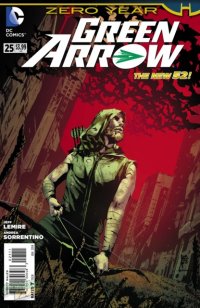 Green Arrow #25 (DC Comics, $3.99)
Green Arrow #25 (DC Comics, $3.99)
by Graig Kent
Oh how I love to be cynical with virtually every decision DC editorial makes these days… with their serious lack of respect for their readership’s investment in their characters and world, as well as their seeming disregard for creative integrity, and a cash-grabby opportunistic mind set, they have more than earned my cynicism. The decision to extend Scott Snyder’s “Zero Year” story from the main Batman title across a number of DC books once again seemed, from my jaded perspective, as yet another editorially mandated capitalization and dilution of something that’s working very well in one specific situation.
But even if all the other “Zero Year” tie-ins are utter crap and contribute nothing to their respective series or the main title, I’m happy to have Green Arrow #25. This is pure fun with two staples in the middle.
I recognize that everyone might not share my enthusiasm, it really depends on how invested you are in the CW Arrow TV show for how much enjoyment you’ll get out of this. But I went from being a cautious observer of Arrow to downright loving it by the end of the first season (and have been equally hyped by this second season). When writer Jeff Lemire and artist Andrea Sorrentino took over the New 52 Green Arrow, it seemed there was at least a hint of the Arrow TV show seeping into rebuilding the troubled property. Now that the show is a definite success, it makes sense that Lemire needn’t hold back in tying this book closer to its mass market sibling, and a Zero Year-done-in-one provides the perfect opportunity to do so.
Zero Year in Batman found the prodigal Wayne returning home to take his place in Gotham society, and a similar parallel is made in Seattle with the prodigal Queen also finding his way home after a 5-year absence. But Oliver, like Bruce, isn’t ready to settle back into society, and he’s not quite the party playboy he once was. He’s a changed man. When he learns his mother is in Gotham when the Riddler’s attack blacks the city out, Oliver makes his way there to find her (it’s ludicrous how quickly he makes it there, but shut up, don’t spoil my fun). Criminals are taking advantage of the darkness in Gotham and an early version of perhaps the Killer Moth shows up to take Moira Queen hostage, and her two bodyguards, including John Diggle, are unprepared. Thankfully there’s both a Bat and an Archer on-scene.
Not only pulling in Walter, Moira, Diggle and Roy from the TV show, Lemire also takes inspiration from Batman: the Brave and the Bold cartoon, and establishing a petty rivalry between Batman and Green Arrow from the start. It’s highly amusing. You wouldn’t think Sorrentino’s style would lend itself well to more lighthearted storytelling but his clever panel structures enhance the humour as much as the drama. As always Sorrentino’s contribution to the book is impressive and incredible, measuring up with Francesco Francavilla on the creative layouts, though still not even close to catching up to J.H. Williams III.
Like Snyder’s Batman, this 25th issue of Green Arrow is longer in length and features a back-up story connected to the main story. Here, illustrated by Denys Cowan (in really fantastic form), Lemire further cements Diggle’s role in the comic book mythos of Green Arrow, planting seeds to flower at a later date.
For fans of Arrow:
Rating: 




Out of a Possible 5 Stars
For not-so-fans of Arrow:
Rating: 




Out of a Possible 5 Stars